(Now with a handful of minor corrections and an update.)
With the President overriding his advisers to deliver insulting remarks and empty threats at the UN and Kim Jong Un responding personally and at some length, one really wonders where all this ends.
John Kelly, left, reacts as he listens to President Trump’s U.N. speech. (Photo: Mary Altaffer/AP) https://t.co/mPR68T7rJ4 pic.twitter.com/MGNQ2jVWVc
— Colin Campbell (@colincampbell) September 19, 2017
Short of war, neither side can compel the other to stop doing what it doesn’t like. Indeed, we are liable to keep goading each other to action for some time to come, a perfectly counterproductive result for both sides. But everything must end. One way or another, the cycle of threats and counter-threats will conclude.
Shall we assume, in the interests of sanity, that everyone comes out of this mess more or less unscathed? Yes, let’s. It’s less likely than ever that North Korea will abandon its nuclear arsenal. (Can we skip the obligatory “pursuit of,” seeing as they have nuclear weapons already?) So, in the best case, we’ll look back at the first year or so of the Trump Administration as a temper tantrum, a transient refusal to accept the emergence of a new mutual deterrence relationship (and one with a lesser power). It’s now America’s third such relationship, alongside those with Russia and China.
Last week, I had the opportunity to speak briefly on this subject at the Air Force Association’s massive Air, Space & Cyber Conference. The first speaker, Deputy Chief of the Air Staff Lt. Gen. Jack Weinstein, remarked on the unusual size of the audience for a panel on nuclear deterrence. It seems they don’t typically run out of chairs. This year has been… special.
Standing room only… pic.twitter.com/S7OAaupziD
— Joshua H. Pollack (@Joshua_Pollack) September 19, 2017
In hope of sparking a wider conversation, I’m posting my slides here, along with a few comments and explanatory asides. Obviously, what follows represents only my own thoughts, not those of the Air Force Association, the U.S. Air Force, or anyone else. Think of it as my own little unsolicited contribution to the Nuclear Posture Review.
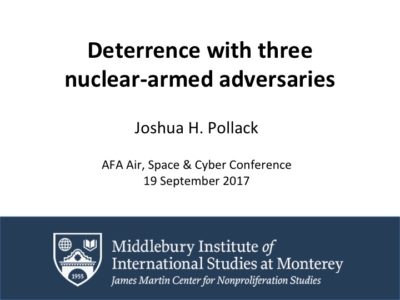
Perhaps needless to say, this presentation doesn’t represent Middlebury, either!
Slide 1
Here are my opening questions.
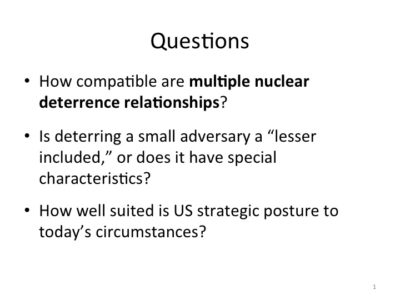
You may notice that I don’t address arms control or disarmament anywhere in this briefing. It’s meant only to prompt some thinking about how to design strategic forces under the present circumstances. The verge of a multi-decade force modernization campaign, whether we like being there or not, seems like an opportune moment to examine some basic considerations for the future force. Of course, if any problems that arise from this analysis appear intractable, answers must be found beyond making unilateral decisions about force posture.
Slide 2
My point of entry into these issues isn’t leadership perceptions, nuclear doctrine, counterforce requirements, or anything of that sort. It’s just the most elementary, tangible aspect of the problem: geography. So here, below, is the mainstay of this presentation: colored dots and arrows overlaid on an orthographic polar projection map.
The arrows represent the surface tracks of missile flights, so yes, they really ought to be slightly curved. Such is life. For want of anything better, this presentation was developed in PowerPoint, augmented with an advanced modeling tool designated “Mk. I human eyeball.”
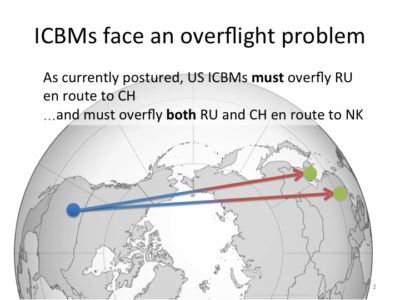
What we see here is an ICBM launch from Malmstrom Air Force Base (approximately) to arbitrary points in North Korea and China. The blue arrows turn red as they cross over Russian airspace. Russia has a large, alert nuclear arsenal, supported with an early-warning network and a launch-on-warning doctrine. I assume Santa Claus has neither of the latter things, although if he did, that would be pretty awesome.
Is Russia’s position between the United States and any other U.S. adversary on the Asian landmass a serious problem? Let’s turn to that question at the end. If it is a problem, there are potential answers within the realm of nuclear posture. Here’s one:
Slide 3
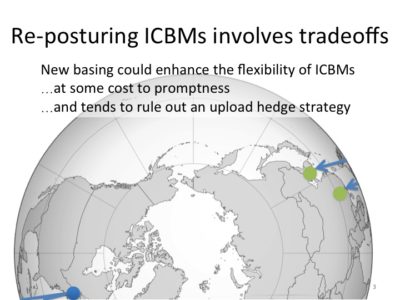
To avoid Russia, just launch south! Going the long way around the planet, a nuclear-armed ballistic missile would probably be employed as a fractional orbital bombardment system, or FOBS. These systems were banned under SALT II, but the treaty never entered into force and has since expired. It would take somewhat longer to get where it’s going than under the current arrangement, and it would also mean (other things being equal) that payloads would have to stay light. These missiles probably could not be “uploaded” with additional warheads as long as they need to be able to fly the southern route.
(To make this slide, I resorted to spinning the globe around in Google Earth a bit to find a route. I’m not sure I got it exactly right, but hopefully the idea comes across.)
Slide 4
Another approach, arguably more elegant, is to say, “The hell with that,” and reserve ICBM targeting for Russia alone. Under this approach, we could leave south-of-Russia missions to the submarine-based force.
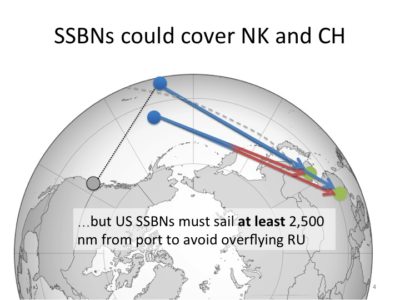
But there’s a rub. If avoiding overflight of Russia will constrain ICBMs, then it will constrain SLBMs, too. The subs must sail quite some distance south and east from their base in Washington State—at least 2,500 nautical miles, by my eyeball—before they enter a region of the Pacific where overflight would not be involved. See that dashed gray curve on the map above?
Note, too, that I happened to choose an arbitrary point in southern China. To cover nearly all of China without passing over Russia—excluding only the very northeastern tip of Chinese territory, which nestles into the curve of the Russian Far East—would require sailing almost 4,500 nm from port, at a minimum. (I’m assuming it’s OK to get to points in China via North Korea.)
Are patrols at these distances unduly stressful for the submarine forces of the present and future? I truly don’t know. But if they are, there’s a fix!
Slide 5
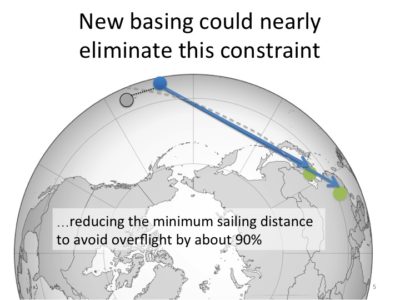
Moving the subs from their docks at Naval Base Kitsap to Pearl Harbor almost eliminates the minimum sailing requirement for targeting North Korea and southern China without overflight of Russia. It also slices about 1,500 nm off the minimum sailing distance to the targeting-almost-all-of-China region. Plus, it’s pretty nice to be in Hawaii.
Here, too, there are tradeoffs. Any subs at dockside in Pearl would be further from Russia than if they were at Kitsap. Perhaps that matters. Perhaps not. (Yes! I am aware that SSBNs patrol in the Atlantic as well.) And there’s a third option, too.
Slide 6
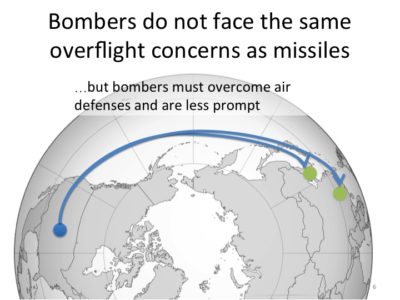
With bombers, the geography of overflight just isn’t that big a concern. They can fly and refuel over friendly countries and oceans, going almost any which way. But it takes them hours to get where they’re going… hours that might not be available, depending on the mission. They can also expect to face advanced air defenses.
Slide 7
On the bright side, there’s a way to eliminate most of those long hours crossing the globe: move the bomber bases closer to the anticipated targets. I’ve picked Guam and Diego Garcia to illustrate the idea:
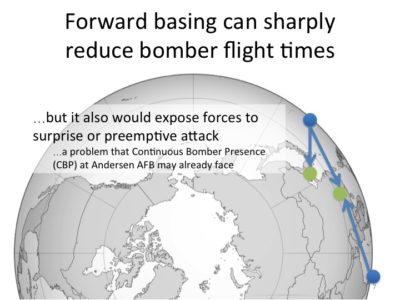
The drawback of this concept is that it makes the bombers themselves more attractive targets. If you take seriously the concerns of the late 1950s about the vulnerability of Strategic Air Command bomber bases to Soviet missiles, why recreate the same sort of problem by relocating nuclear delivery systems within range of the DF-26 and the HS-12?
In the late 1950s, of course, we didn’t have missile subs or ICBMs. Wouldn’t they deter any such strikes? Perhaps they would. Or perhaps new forward-deployed nuclear bomber bases would simply invite adversaries to consider the logic of limited nuclear or conventional counterforce.
Unhappily, we already seem to find ourselves in a version of this predicament by rotating conventionally armed bombers through Guam over the last dozen-plus years. I’m less and less convinced that the increasingly routine Guam-based shows of force in places like Korea and the East China Sea are having the desired effect, while they have offered Kim Jong Un a justification for some pretty aggressive threats. Is this mission already past its sell-by date? Perhaps the best value of these flights is trade bait.
Slide 8
Now here’s the “fun” part, where geography really starts to bite. The Ground-based Midcourse Defense, or GMD, is mostly located in Alaska, with a handful of bonus interceptors in California. Here, I’ve picked three targets from the March 2013 Map of Death and sent North Korean ICBMs whisking toward them (the solid green arrows). [UPDATE: I’ve produced a new post on this issue, but have withdrawn it for the time being in the interests of trying to get it right. Stay tuned.]
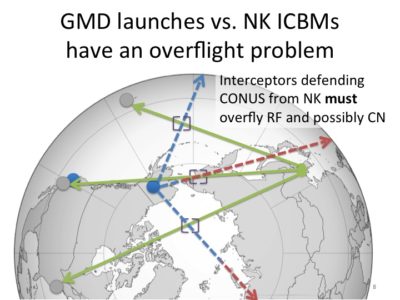
The blue, dashed arrows are interceptors flying out from Ft. Greely, AK in response. Each would be a group of four or so Ground-Based Interceptors, or GBIs, one of which would hopefully connect with the inbound reentry vehicle, or RV, at the points indicated with brackets (as determined with the Mk. I eyeball). The rest of the GBIs will continue merrily on their way and burn up during reentry someplace further south.
You should notice a few things here. Intercepting the shot taken at Pearl Harbor will send GBIs off into the Pacific. That looks pretty harmless. But intercepting the shots aimed at mainland targets means flying out toward Russia. Defending a West Coast target even means engaging the attacking RV above the Russian Far East. Yikes.
Now, maybe that’s not a real problem, since the Russians should be able to see clearly that the radar tracks lead back to Ft. Greely, and not to an ICBM base or to the ocean. On the other hand, Secretary of Defense Robert Gates once disclosed that one of Russia’s concerns about a plan to put GBI silos in Europe was a fear that the interceptors could be quietly refitted with nuclear warheads and turned into weapons of surprise attack. Russia’s steadfast refusal to acknowledge the existence of North Korean ICBMs also stands to complicate how they may interpret such an event.
So, short of getting rid of a program that I frankly despair of, what can be done? One possibility is to enhance real-time data exchange with the Russians, to enable the U.S. to engage small-scale attacks from North Korea without fear that doing so will trigger Armageddon. You may have heard this one before. A second idea is to restrict the interceptors to late shots that would attempt “tail chase” engagements of attacks on the mainland USA, mostly over Canada. (Update: George Lewis suggests this approach could have advantages.) A third idea is…
Slide 9
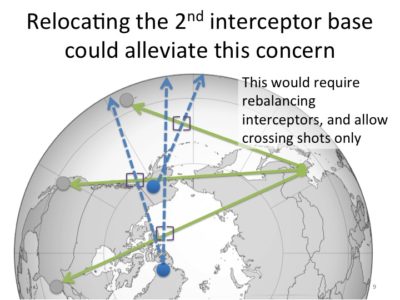
The second interceptor base, located at Vandenberg Air Force Base, doesn’t seem to do too much, other than serve as a flight-testing venue every now and then. Why not confine it to that role, and dig some new silos at Thule Air Base in northwestern Greenland? If the Greenlanders and Danes don’t object, this site could become the main interceptor base, with Ft. Greely primarily defending Hawaii, and the two bases protecting each other if necessary. If the tail-chase-only approach mentioned above is unattractive, this new site would accommodate crossing shots at any North Korean attacks on the U.S. mainland, with GBIs splashing down somewhere in the Pacific. Nothing would need to pass over Russia.
Moving GBIs to Thule would also force Missile Defense Agency spokespeople to learn how to pronounce Pituffik. That alone seems like justification enough.
Slide 10 (finale!)
Now, how to choose between these various options? I don’t know! Fortunately, that’s not my job. In place of recommendations, all I have are more questions. Finding the answers to these questions—not to mention estimating how much various basing options might add to already notoriously expensive modernization plans—could help determine how to redesign the U.S. nuclear posture, if at all.
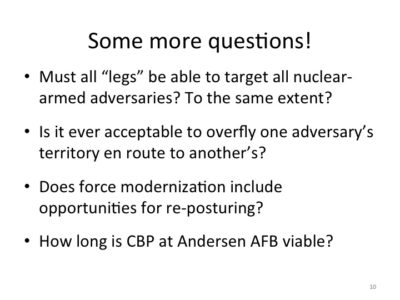
For now, I’ll venture just this much more. There’s an important distinction between the requirements of deterrence and the requirements of damage limitation “if deterrence fails.” China and North Korea, for example, appear not to believe that they need to care about overflying Russia; but then, all they are trying to do is deter a U.S. nuclear strike. They’re not preparing to render one physically impossible by means of a massive strike over the North Pole. A leader in either of those countries is unlikely to place much faith in the idea of Russia as an impermeable shield that wards off attack by U.S. nuclear missiles. But American planners contemplating how to implement a prompt and effective counterforce strike, if ever called upon to do so, conceivably might see the problem differently.
By that reasoning, we might take a little quiet assurance from the status quo. If the various points made here about ICBMs, SSBNs, and bombers leave no impression on the Powers That Be—or, if you prefer, the Forces in Being—it may imply that they just don’t take the prospect of a counterforce mission too seriously. All in all, that’s probably a good thing.

Short of war, neither side can compel the other to stop doing what it doesn’t like.
Of course they can stop us from doing what they don’t like. All it will take is a few 2010 style “provocations,” (acts of war had they been committed by anyone else) in order for America to realize that basing US troops in South Korea isn’t worth our while. That putting targets as far east as Denver at risk of thermonuclear fire in order to protect a South Korean government whose president’s chief of staff served prison time for pro-North Korea activities isn’t really smart.
Then, with North Korea fully armed and South Korea disarmed the next step would be a confederation agreement of the sort that Pyongyang has been talking about for decades.
http://sthelepress.com/index.php/2017/08/11/low-level-confederation-and-the-nuclear-crisis-in-2-parts-b-r-myers/
In any case, I found the rest of the article informative.
And yet, none of this has happened so far. I don’t think it’s halfway so simple.
@Aidan
I don’t think that NK’s goals are simply about getting the US out of S. Korea, otherwise why start shooting missiles over Japan? They want to be treated the same as any other country in the “nuclear club” with the Kim family as de-facto monarchs and to have normalized relations with the rest of the world.
The US is seen as the biggest obstacle to that goal, and pushing around all of the US allies in the region is a way to both make the NK leadership seem stronger domestically and also to provide something to trade in return for a lifting of economic and diplomatic sanctions.
Of course, I don’t think any US leader is willing to back down on this because of the human rights record and because making yourself look weak towards NK makes it more likely that stronger countries, like China, would feel they could get away with pushing around other US allies like Taiwan. The reality is that you can’t just rollback US hegemony in one place and expect other countries to not notice and react on their own to perceived changes in strength.
Well they’re shooting the Hwasong 12 and they will start shooting the Hwasong 14 over Japan to make sure that they work. They can’t coerce the US to leave South Korea unless they demonstrate to us that they can strike this country.
Of course I don’t think that North Korea would object to normalization of relations but that isn’t their primary goal; otherwise, why would they do all of the things that isolated them in the first place. I don’t think that they would give up anything to achieve diplomatic normalization.
On your third point you are exactly right that a surrender in South Korea will be the end of US hegemony, but that isn’t going to matter as soon as the domestic population sees their sons coming home from Korea in flag-draped coffins. The global implications of this are indeed more far reaching than most of us realize. I imagine that US hegemony and the alliance system and indeed in no particular order South Korea, Taiwan, the South China Sea, the Baltic States,etc will fall and we’ll still be writing op-eds about how Kim Jong Un only wants nukes to avoid having his country turned into Libya.
Hi Joshua – Did you consider the apogee of the ICBM trajectory in your overflight analysis? Any segment of the flight above the Kármán line (100Km – space) would likely not be considered as overflight.
Nope. These are just approximations of ground tracks. Look, this shouldn’t be understood as any sort of legal argument. It has to do with Russian fears of surprise attack. Even an apparent overflight through space might be interpreted as an attempt to dazzle radars, as a prelude to attack.
Thanks. Under this logic satellites flying over Russia would trigger these false alarm too. The warning systems is all about predicting trajectories to identify threats which are not satellites. To give perspective – we are not talking about slightly curved lines over the globe like an airliner flight path or even a cruise missile: A 12,000Km ICBM shot can have an apogee higher than 1,000Km – making the re-entry for the final 100Km drop through ‘territorial airspace’ at an angle greater than 50 degrees. This is a reasonably good illustration of the flight profile to illustrate the point: https://1.bp.blogspot.com/_JGRd43QLug8/RkESmw4pB6I/AAAAAAAAA9M/cv5-28Ek3vs/s400/trajectory.gif
An interesting point! For whatever it’s worth, Except for Jim Woolsey, no one sees LEO satellites as nuclear threats. It would be interesting to know why. Perhaps there is simply a limit to how much paranoia an otherwise healthy mind can accommodate?
The question is probably around how quickly the Russians can characterise the flight path after a launch is detected, and around the uncertainty in the target area due to the ability of both the launcher and RV to manoeuvre.
In contrast the orbital trajectories of satellites are well characterised and clearly not a threat.
Considering the hysterical, manipulative response by the Japanese Government and media to the “overflight” of Hwassong 12 missiles, followed by US rhetoric, I wouldn’t put much trust in the customary space boundaries. What I mean by this is that by the time the Japanese authorities had detected which way the hwassong 12s were flying they knew perfectly well that the trajectories were 550 & 770 KM respectively and it was physically impossible for them to fall on Japan. None the less, the Japanese authorities sounded a “missile altert” to the civilian population, ratcheting up the crisis by induced public paranoia.
I don’t think that’s what happened. The government has to warn its citizens as early as possible so they can get to shelter. It appears to me that they are probably relying on very early infrared data, while the missile is still boosting. Only later, when the RV crosses the radar horizon, would it become fully apparent where it is headed.
In addition to technical arguments, there is the likely rationality of nuclear political decisions. If Russia would fear a surprise nuclear strike (post-Cold War), it needs to be during a severe crisis involving both Russia and the United States. If the crisis clearly involves the U.S. and North Korea, and Russia suddenly sees a smallish number of missiles heading over Siberia towards North Korea, the logical conclusion is that the U.S. is attacking North Korea.
For Russia to counter-attack the U.S. because of an attack on North Korea would be a rather obvious catastrophic blunder for Russia. Nevertheless, there is a small chance that Russia could make this mistake, resulting in additional catastrophe for the U.S. Therefore, in planning for nuclear capabilities for the next 10-50 years, it makes sense to build in some capability to attack non-Russian countries without overflying Russia.
Here are better lines for NK trajectories:
https://i.imgur.com/mUvucOm.png
I also made three lines from hypothetical missile locations that are 1000 km each. I don’t think bases in Thule or Alaska are really well suited for GMD missile bases that protect NY or DC. Missiles have to travel roughly 1000 km orthogonal to intercept a warhead. Base somewhere in Victoria Island or Banks Island would be better.
And “the Brits,” never pulled out of “the North of Ireland,” either but then, nobody doubted the IRA when they said that they wanted:
“A war of attrition against enemy personnel which is aimed at causing as many casualties and deaths as possible so as to create a demand from their people at home for their withdrawal.”
https://en.m.wikipedia.org/wiki/The_Green_Book_(IRA)
I think the North Koreans have a better chance of succeeding firstly because the Provos never got hydrogen bombs and secondly because the ideological and geographical and linguistic gaps between James Molyneaux and Margaret Thatcher were much narrower than those between Donald Trump and Moon Jae-in.
When you consider that the IRA were a bunch of cretins from West Belfast and Londonderry who considered victory against a military superpower as something that could be achieved the idea of North Korea prevailing or at least thinking it can prevail against America is very easy to see indeed. Especially of course when you consider that North Korea has never suffered retaliation from the US or South Korea for any of its post armistice attacks.
Joshua – thanks for 1) talking sense at the AFA meeting, 2) pointing out the innate hazards of having both BMD and ICBMs in the face of bad Russian sensors that cannot realistically distinguish between an ICBM decapitation attack and the debris of successful BMD defense of the US East Coast from DPRK attack.
I wish your sense had been included in the recent Brookings discussion and report on deterrence as the only mention of BMD is some half-baked marketing material on the wonders of BMD despite its pathetic record on the test range.
Sadly – I suspect that we can’t rationally have a discussion about real deterrence for a few more years as the present administration does not care about credible deterrence if that gets the in way of generating a few more headlines about the US throwing away decades of carefully built credibility.
@Joshua Pollack
http://www.dailynk.com/english/m/read.php?num=14721&cataId=nk03600
Again, nothing I’m saying isn’t something that the North Koreans are not saying themselves.
I understand in a way why the mainstream media seems to have largely ignored the threat of an EMP attack by North Korea. After all, what really would we be able to do? Would the marginally effective Ground-Based Mid-course Defense be able to handle an ICBM from North Korea targeted and fused for a 400km+ altitude detonation? Why have people running mad in the streets with panic.There is also the seemingly common perception that EMP is some kind of science fiction phenomenon, when in fact it is very real. Just Google “Project K”, “Test 184”, or even “Starfish Prime”, and you will find out just how real it is. I just find it incredible how so many people are apparently in denial of the very likely ability of NK to seriously threaten our way of life on this continent. On the 3 September North Korea released pictures to the world of Kim Jong-Un inspecting “the peanut”, hours before a successful test of a relatively high-yield (but visibly different from the one in the picture) device. The KCNA clearly stated that North Korea had developed such a device specifically for EMP attacks on the US: I think we should take them seriously. I am pretty certain NORAD has for some time, as they moved their base of operations back into Cheyenne Mountain in 2015 after nine years of the facility being in “warm standby”, but not before spending 700 million to upgrade the systems there against EMP. I feel that with North Korea’s statement that the next nuclear test will be a demonstration of the entire system “end-to-end” over the North Pacific, the US is currently left with no choice but to destroy any IRBM or ICBM they detect being generated for launch by them. There will be no way to know in advance if it carries a nuclear warhead, no way to know if it will be a test or a pre-emptive strike against the US (as threatened by North Korea), added to the fact that that North Korea has already stated by virtue of the intended test location, the North Pacific, that a nuclear armed missile of questionable reliability will be overflying Japan, a US ally that they are bound by agreement to protect. A big question is if pre-emptively striking North Korea in such circumstances will satisfy China’s expressed intention not to come to North Korea’s aid if they are found to be the ones who initiate hostilities. If the US does pre-emptively strike a North Korean ballistic missile in the process of being readied, I think it will be “in for a penny, in for a pound”, as such an attack would likely be viewed by North Korea as the last straw, and reason to respond massively, against South Korea, against Japan, and probably against the US. The US would also be bound to prevent as much damage and suffering to it’s allies as possible. It is madness, yes, but madness that certain senior officers have apparently decided is manageable. I hope they are correct, because as a lot of experienced soldiers say, “no plan of battle ever survives contact with the enemy”.
Honolulu is still there, so I wonder if this isn’t overblown. But never mind! You do realize how this works, right? The prospect of retaliation is meant to stay the hand of a would-be attacker. That, in essence, is what’s meant by deterrence.
I am well aware of what deterrence is Joshua, but thank you anyway for your brief tutorial. Honolulu is indeed still there, proving nothing with regards to deterrence continuing to work in the future. The possibility of a nuclear EMP attack on the US and the nature of it’s terrible consequences are very real, and I feel anybody who has read the “Report of the Commission to Assess the Threat to the United States from Electromagnetic Pulse (EMP) Attack”, completed in 2008, would agree. The large numerical disparity in nuclear weapons and delivery systems between North Korea and the US results in an asymmetrical deterrence regime, especially when some people in the US administration and elsewhere may feel that the threat from a nuclear EMP attack is “overblown”, and that having the ability to carry one out does not confer upon North Korea the ability to inflict a catastrophically high level of death and destruction upon the US, despite their aforementioned numerical inferiority in weapons systems. As has been pointed out by others, it is highly likely that a country with fewer nuclear weapons is more likely to use them first, rather than lose them (and themselves) in what they see as an impending, regime-ending decapitation strike. This is especially more so in the case of a nation like North Korea; small, isolated, and ruled by an ultra-nationalistic regime that exhibits very high levels of paranoia, and which repeatedly threatens to inflict complete destruction upon the US. Conversely, the current leader of the US, not exactly noted for rational, reflective behavior, may feel he has to act now rather than later, before North Korea comes to possess enough nuclear weapons and delivery systems to make the deterrence regime a more symmetrical one, where the US is forced to live with a threat that they deem unacceptable, and where North Korea feels it may then be able to act with complete impunity. In short, deterrence fails when one party in a deterrence relationship doesn’t feel sufficiently deterred to prevent them from acting.
I don’t see the part about “it is highly likely that a country with fewer nuclear weapons is more likely to use them first, rather than lose them (and themselves) in what they see as an impending, regime-ending decapitation strike.” If a strictly conventional U.S. strike appears aimed at nuclear/missile sites (however foolish that might be), it is probably not a “regime-ending decapitation strike” even if panicky DPRK leaders think it might be.
Using nukes first for fear of losing them is a suicidal response, therefore not rational for non-suicidal people. It is better for DPRK leaders to hunker down and hope to survive than to use nukes first and commit suicide for sure. While it’s possible that panicky leaders might use nukes first, DPRK leaders would be better advised to respond some other way.
Thanks for complicating matters in a helpful way, Josh.
MK
Thank you for your thoughts, Joshua. I read your follow up comments yesterday and this morning, but now the link appears to be broken. There is only a scuba diver there. What happened to your blog? Could you please repair or repost it? Thanks! Judy Lipton
Yes, I pulled the post down for the time being. I got some feedback indicating that it was wide of the mark. I need to take a little more time to work on it…